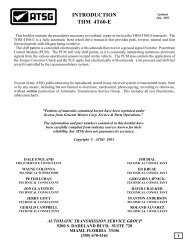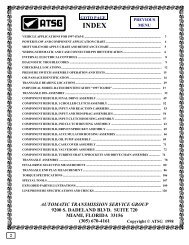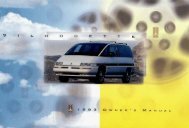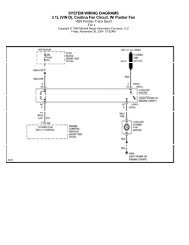Controls
Controls
Controls
Create successful ePaper yourself
Turn your PDF publications into a flip-book with our unique Google optimized e-Paper software.
Your Driving and the Road<br />
Skidding<br />
In a skid, a driver can lose control of the<br />
vehicle. Defensive drivers avoid most<br />
skids by taking reasonable care suited to<br />
existing conditions, and by not<br />
“overdriving” those conditions. But skids<br />
are always possible.<br />
The three types of skids correspond .to<br />
your Pontiac’s three control systems. In the<br />
braking skid your wheels aren’t rolling. In<br />
the steering or cornering slud, too much<br />
speed or steering in a curve causes tires to<br />
slip and lose cornering force. And in the<br />
acceleration skid too much throttle causes<br />
the driving wheels to spin.<br />
A cornering skid is best handled by<br />
easing your foot off the accelerator pedal.<br />
If you have the traction control system,<br />
remember: It helps avoid only the<br />
acceleration skid. If you do not have<br />
traction control, or if the system is off,<br />
then an acceleration skid is also best<br />
handled by easing your foot off the<br />
accelerator pedal.<br />
If your vehicle starts to slide, ease your<br />
foot off the accelerator pedal and quickly<br />
steer the way you want the vehicle to go.<br />
If you start steering quickly enough, your<br />
vehicle may straighten out. Always be<br />
ready for a second skid if it occurs.<br />
Of course, traction is reduced when water,<br />
snow, ice, gravel, or other material is on<br />
the road. For safety, you’ll want to slow<br />
down and adjust your driving to these<br />
conditions. It is important to slow down<br />
on slippery surfaces because stopping<br />
distance will be longer and vehicle<br />
control more limited.<br />
While driving on a surface with reduced<br />
traction, try your best to avoid sudden<br />
steering, acceleration, or braking<br />
(including engine braking. by shifting to a<br />
lower gear). Any sudden changes could<br />
cause the tires to slide. You may not<br />
realize the surface is slippery until your<br />
vehicle is skidding. Learn to recognize<br />
warning clues -- such as enough water,<br />
ice or packed snow on the road to make a<br />
“mirrored surface” -- and slow down<br />
when you have any doubt.<br />
Remember: Any anti-lock braking system<br />
(ABS) helps avoid only the braking skid.<br />
Driving at Night<br />
\Tight driving is more dangerous than day<br />
hiving. One reason is that some drivers<br />
re likely to be impaired -- by alcohol or<br />
lrugs, with night vision problems, or by<br />
atigue.<br />
-€ere are some tips on night driving.<br />
D<br />
D<br />
D<br />
Drive defensively.<br />
Don’t drink and drive.<br />
Adjust your inside rearview mirror to<br />
reduce the glare from headlights<br />
behind you.<br />
... 158








